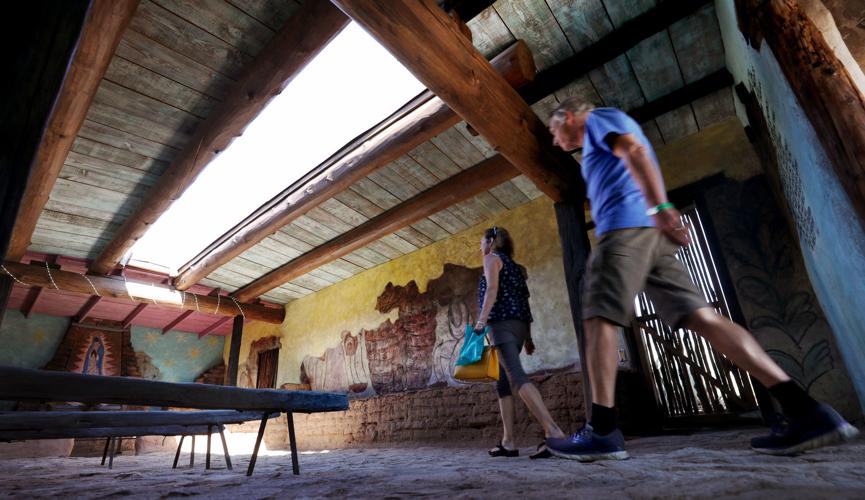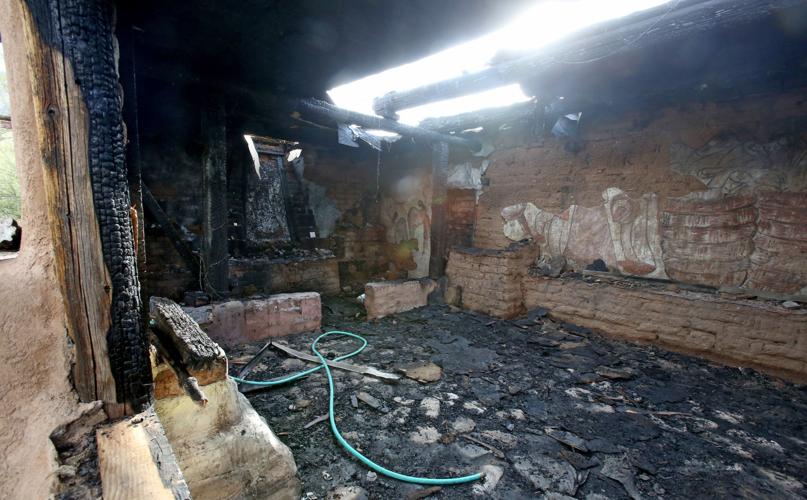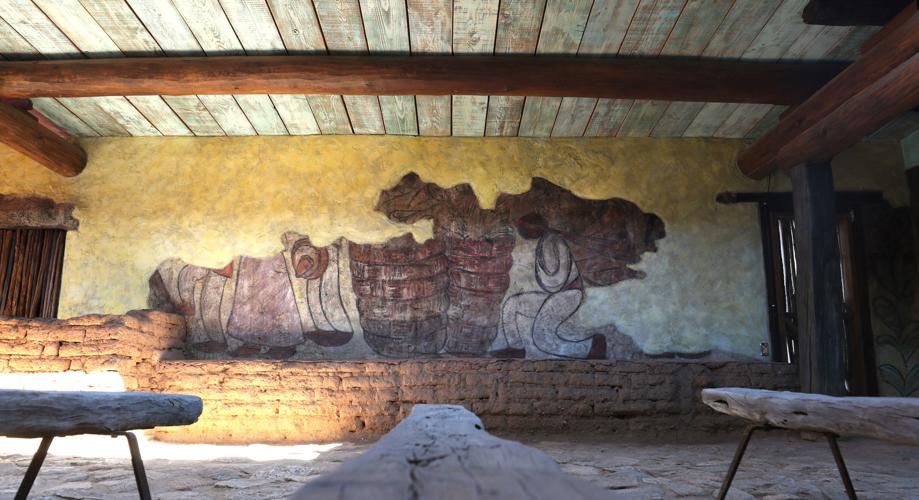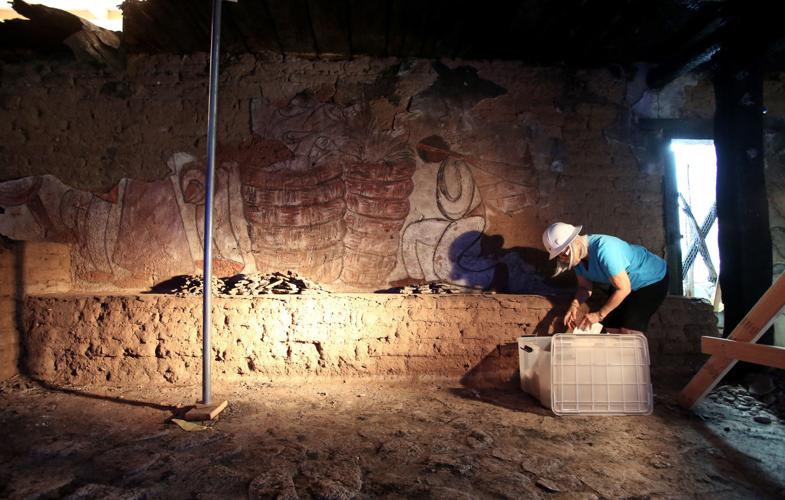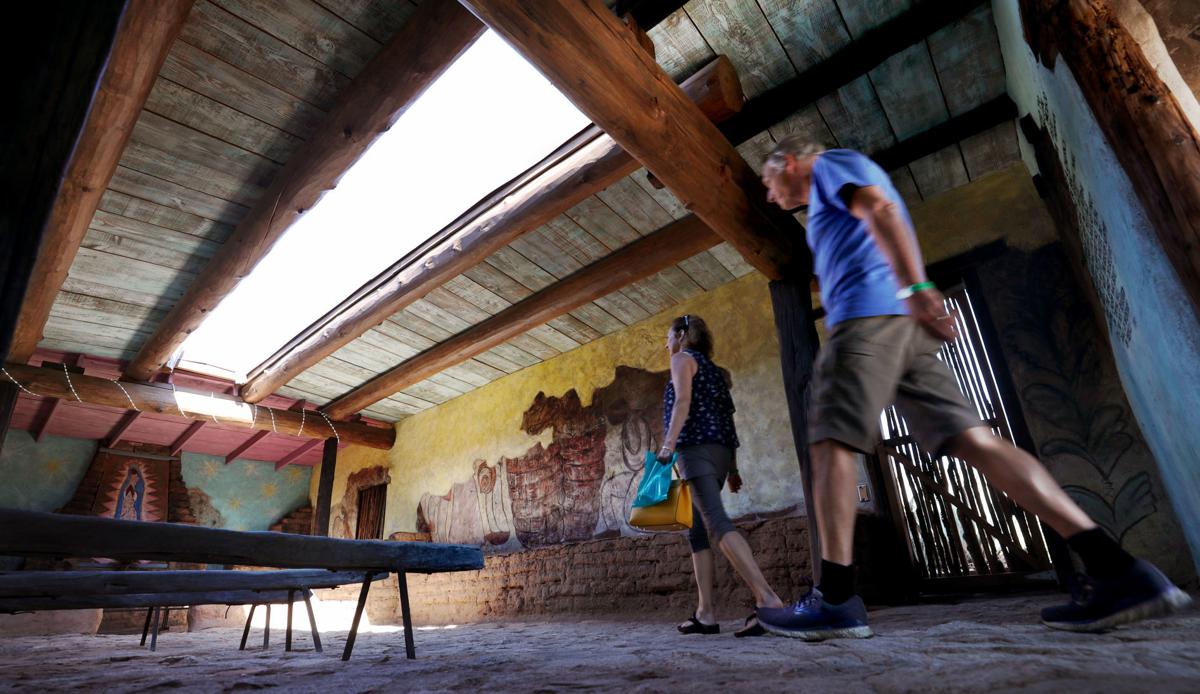A string of green rosary beads. An orange lily in a glass vase. A plastic toy go-kart from a McDonald’s Happy Meal.
Offerings are collecting once again on the altar at Ted DeGrazia’s Mission in the Sun.
Two and a half years after a fire that nearly destroyed the chapel, the DeGrazia Foundation has quietly reopened the restored adobe building at the famed artist’s gallery in the Catalina Foothills.
“We jumped through so many hoops to get this done,” said Lance Laber, the foundation’s executive director.
The gallery plans to hold a Catholic Mass and a formal rededication of the mission on Dec. 8, as part of its annual Fiesta de Guadalupe.
“It’s fantastic,” said Domingo DeGrazia, the artist’s youngest son, now a member of the Arizona House of Representatives. “We’re back to having a Tucson landmark that a lot of people pray in and a lot of people have gotten married in. … I think Tucson is going to be really happy to have that back.”
Ettore “Ted” DeGrazia built the mission in 1952 as a tribute to Father Eusebio Kino and Our Lady of Guadalupe, a venerated image in the basilica in Mexico City that draws pilgrims from around the world.
Laber said the foundation began letting people inside the mission again about two months ago, after getting final approval from Pima County.
Almost immediately, visitors started leaving sacrificial gifts and lighting candles, just like the ones blamed for the May 29, 2017, blaze.
Laber said the fire destroyed the building’s roof and wiped out about 80% of the murals DeGrazia painted on the interior walls. Much of the artwork that survived was darkened by smoke, muting the once-vibrant colors.

The mission was built by Ettore “Ted” DeGrazia in 1952 as a tribute to Father Eusebio Kino and Our Lady of Guadalupe. Much of the artwork that survived was darkened by smoke.
Eric Means, with Means Design and Building, was brought in to stabilize the walls and reconstruct the roof, using guidelines set out by the National Register of Historic Places.
The interior walls were plastered over to secure what was left of the original paintings, but no effort was made to re-create the artist’s work.
“I didn’t want to repaint in here. I didn’t want to fake the murals,” Laber said.
Instead, the foundation called on artist Ginny Moss Rothwell, who was mentored by DeGrazia in the 1970s, to paint the new plaster with background colors befitting DeGrazia’s style and preferred palette.
A row of simple, wood and metal benches crafted by DeGrazia have been restored and returned to the chapel after being scorched by the fire.
“They kind of look like skinny little French fries, but they’re original,” Laber said. “It’s amazing what we were able to salvage.”
Some signs of the fire have been left on purpose.
During a tour on Friday, Laber pointed to charred roof beams above the entrance to the chapel — the faint blue petals of one of DeGrazia’s painted flowers still visible on the blackened wood.
“It’s amazing they managed to save this. It was just getting ready to go,” Laber said.
Nearby, DeGrazia’s painting of Father Kino on horseback is still stained with black soot.

“It’s amazing they managed to save this. It was just getting ready to go,” said Lance Laber, the foundation’s executive director. “Having 90% of it back is better than having none of it.”
Laber said the fire is “part of the history of the place now. You’re aware that something happened in here.”
The replacement for one work destroyed by the fire was helpfully provided by DeGrazia himself.
In a trapezoid-shaped space above the mission’s altar, the artist had painted his own version of Our Lady of Guadalupe directly onto the adobe wall.
After the work went up in flames, the gallery discovered a canvas in that same, trapezoid shape, also featuring Our Lady of Guadalupe rendered in colored beeswax.
The painting, which had been on display for years in the gallery’s “gold room,” turned out to be a perfect fit for space above the altar.
Laber doesn’t know what DeGrazia, who died in 1982, would think of the restoration work. It’s a question that’s kept him up at night, he said, but he knows there’s only so much anyone can do when the original artist isn’t around anymore.
“If he was alive today, he’d just repaint this stuff. Having 90% of it back is better than having none of it,” Laber said with a shrug.
He said some precautions have been taken to prevent another fire. A metal candle rack, similar to those used in Catholic churches, was installed so only votives in glass containers can be used.
But there are no plans to stop visitors from treating the mission as the spiritual place DeGrazia intended it to be, Laber said.
“People have been lighting candles in here for a long, long time,” he said. “I get it. People really hold this place in some reverence.”

About 80% of the murals DeGrazia painted on the interior walls were wiped out by the fire. The walls were plastered over to secure what was left of the original murals.
DeGrazia Mission in the Sun, fire and restoration
Photos: DeGrazia Mission in the Sun, fire and restoration
DeGrazia Mission in the Sun
Updated
Shannon Stone, the education director at DeGrazia Gallery in the Sun, at 6300 N Swan Rd., looks through an open window as she surveys the damage to the historic chapel in Tucson, on May 30, 2017. "We're all just devastated here," she said. "We'll have to rebuild," The fire, which started Monday evening, heavily damaged the structure that was built in 1952.
Ted DeGrazia
Updated
In 1952, Ted DeGrazia built the Mission in the Sun as the first building constructed on the property in memory of Padre Eusebio Kino, a Jesuit priest, and dedicated the mission to Our Lady of Guadalupe. Following his own building plans, DeGrazia and his friends carefully handcrafted the adobe constructed building. In 2006, the Mission in the Sun was registered as a National Historic landmark.
DeGrazia Mission in the Sun
Updated
In the early 1950s, Ted DeGrazia began building his Mission in the Sun, part of what is now his Gallery in the Sun on North Swan Road.
DeGrazia Mission in the Sun
Updated
A DeGrazia mural and the surrounding chapel wall is badly damaged as local resident Ben Gell peers through an open doorway at DeGrazia Gallery in the Sun, at 6300 N Swan Rd., in Tucson, on May 30, 2017. The fire, which started Monday evening, heavily damaged the structure that was built in 1952.
DeGrazia Mission in the Sun
Updated
The charred remains of the altar area in the DeGrazia Chapel at DeGrazia Gallery in the Sun, at 6300 N Swan Rd., in Tucson, on May 30, 2017. The fire, which started Monday evening, heavily damaged the structure that was built in 1952.
DeGrazia Mission in the Sun
Updated
Some debris is still on the floor at the DeGrazia Chapel at DeGrazia Gallery in the Sun, at 6300 N Swan Rd., in Tucson, on May 30, 2017. The fire, which started Monday evening, heavily damaged the structure that was built in 1952.
DeGrazia Chapel fire damage
Updated
Shannon Stone, the education director at the DeGrazia Gallery in the Sun, surveys the damage to the historic chapel a day after a Memorial Day fire swept through the structure.
DeGrazia Chapel fire damage
Updated
Fire damaged the chapel last evening at DeGrazia Gallery in the Sun, at 6300 N Swan Rd., in Tucson, on May 30, 2017. The fire, which started Monday evening, heavily damaged the structure that was built in 1952. It was built in memory of Padre Eusebio Kino and dedicated to Our Lady of Guadalupe.
DeGrazia Chapel fire damage
Updated
Fire damage at DeGrazia Gallery in the Sun, at 6300 N Swan Rd., in Tucson, on May 30, 2017. The fire, which started Monday evening, heavily damaged the structure that was built in 1952. It was built in memory of Padre Eusebio Kino and dedicated to Our Lady of Guadalupe.
DeGrazia Mission in the Sun
Updated
Murals line the walls in the Mission in the Sun chapel at the DeGrazia Gallery in the Sun, 6300 N. Swan in 2007.
DeGrazia Mission in the Sun
Updated
DeGrazia murals inside the chapel at the DeGrazia Mission in the Sun in 2009.
DeGrazia Mission in the Sun
Updated
The inside of the chapel is covered with murals at the DeGrazia Mission in the Sun before the fire in 2009.
DeGrazia Mission in the Sun
Updated
Visitors take a look at the Mission in the Sun at the DeGrazia Gallery in the Sun in 2005.
DeGrazia Chapel Restoration
Updated
Dust rises in the air as Earl Jackson, with Means Design & Building, removes a layer of dirt from the floor as best as possible during the restoration process at the DeGrazia Chapel. A fire destroyed the interior of the chapel, at 6300 N Swan Rd., on Memorial Day 2017 closing it down for almost two years. The vestibule, right, suffered mostly smoke damage. The chapel was built by artist Ted DeGrazia in 1952 in memory of Padre Eusebio Kino and dedicated to Our Lady of Guadalupe.
Degrazia Chapel restoration
Updated
Surrounded by bracing and a tarp that is being used for protection, Lance Laber, middle, the executive director of the DeGrazia Gallery in the Sun and conservator Charlie Burton stand in the Mission in the Sun in Tucson on August 31, 2017. The chapel was heavily damaged in a fire last May that almost destroyed the structure that was built by artist Ted DeGrazia. A.E. Araiza / Arizona Daily Star
DeGrazia Chapel restoration
Updated
Conservator Charlie Burton examines a big piece of plaster from the damaged mural on the right at the DeGrazia Mission in the Sun as efforts are still being made to restore the famous chapel in Tucson on Oct. 2, 2017. The chapel was heavily damaged in a fire last May that almost destroyed the structure that was built by artist Ted DeGrazia. A.E. Araiza / Arizona Daily Star
DeGrazia Chapel restoration
Updated
A portion of the mural is still intact as the shadow of conservator Charlie Burton falls on it as she works on collecting some of its pieces at the DeGrazia Mission in the Sun as efforts are still being made to restore the famous chapel in Tucson on Oct. 2, 2017. The chapel was heavily damaged in a fire last May that almost destroyed the structure that was built by artist Ted DeGrazia. A.E. Araiza / Arizona Daily Star
DeGrazia chapel restoration
Updated
Conservator Charlie Burton uses a brush as she uncovers a small urn near the altar at the DeGrazia Mission in the Sun where she is recovering mementos in Tucson on Dec. 5, 2017, following the fire that nearly destroyed the building. Burton has been trying to salvage as much of the artwork and artifacts before the restoration process takes place next year. The fire swept through the iconic structure last Memorial Day. A.E. Araiza / Arizona Daily Star
DeGrazia Chapel Restoration
Updated
Walls that once had colorful murals painted by Ted DeGrazia are now bare as Mario Miranda, with Means Design & Building, works in the entryway making some of the finishing touches to the DeGrazia Chapel. Also new is the roof including huge vigas, or logs that support the roof.
DeGrazia Chapel Restoration
Updated
Bondo filler is used by Octavio Egurrola as he patches a viga, or wooden beam, as some of the finishing touches in the restoration process are made on the DeGrazia Chapel. A fire destroyed the interior of the chapel, at 6300 N Swan Rd., on Memorial Day 2017, closing it down for almost two years. The roof was replaced as well as the support beams.
DeGrazia Chapel Restoration
Updated
Octavio Egurrola, with Means Design & Building, injects a clay adhesive between the plaster and the adobe wall as he does some of the finishing touches in the restoration process on the DeGrazia Chapel. The adhesive is meant to attach the outer plaster with the adobe wall, which over time has separated.
DeGrazia Chapel Restoration
Updated
A door, made of saguaro ribs with a wooden frame, is scraped down by Earl Jackson, with Means Design & Building, at the DeGrazia Chapel. Also new is the roof including huge vigas, or logs that support the roof. Some of the surviving murals are still visible on the right.
DeGrazia Chapel Restoration
Updated
Standing on the altar, Mario Miranda, with Means Design & Building, scrapes away some of the blackened residue where the image of the Virgin of Guadalupe was once painted at the DeGrazia Chapel. A fire destroyed the interior of the chapel, at 6300 N Swan Rd., on Memorial Day 2017 closing it down for almost two years.
DeGrazia Chapel Restoration
Updated
With trowel in hand, Eric Means, with Means Design & Building, gets ready to put some lime plaster on the wall behind him in the vestibule of the DeGrazia Chapel. The murals in the room sustained mostly smoke damage. Black, soot-stained walls on the right are signs of the fire that heavily damaged the inner chapel, right.
DeGrazia Chapel Restoration
Updated
An encaustic painting of Our Lady of Guadalupe by artist Ted DeGrazia is examined by collections manager James Jenkins and director Lance Laber. The painting, made with beeswax, was once on the altar of the chapel but was replaced by a mural of the Virgin Mary that DeGrazia painted directly on the wall.
DeGrazia Chapel Restoration
Updated
DeGrazia's executive director Lance Laber and Eric Means, with Means Design & Building, lift a Ted DeGrazia encaustic painting into place on the altar. Decades ago, the same art piece was once over the altar but was removed and replaced with another mural of the Virgin painted by DeGrazia.
DeGrazia Chapel Restoration
Updated
Executive director Lance Laber takes a photograph of a Ted DeGrazia encaustic painting made of beeswax and depicting Our Lady of Guadalupe that was put in place on the altar at the DeGrazia Chapel. Decades ago, the same art piece was once over the altar but was removed and replaced with another mural of the Virgin by DeGrazia.
DeGrazia Chapel Restoration
Updated
Visitors stand in the doorway as they watch artist Ginny Moss Rothwell use a dry brush method to apply some yellow and white paint surrounding one of murals at the DeGrazia Chapel. It was decided to restore the chapel structurally but not the murals and to have Rothwell paint around the images.
DeGrazia Chapel Restoration
Updated
Artist Ginny Moss Rothwell works along the east wall as she applies some yellow and white paint surrounding one of murals at the DeGrazia Chapel. It was decided to restore the chapel structurally but not the murals and to have Rothwell paint around the images.
DeGrazia Chapel Restoration
Updated
This is a series of photos taken in 2013 by artist Ginny Moss Rothwell who uses them as a guide while she paints around the murals at the DeGrazia Chapel. Several photographs are lined up in sequence to give an idea of what the whole wall once looked like.
DeGrazia Mission in the Sun
Updated
Local photographer Chris Richards surveys the damage including the charred benchs of the DeGrazia Chapel at DeGrazia Gallery in the Sun, at 6300 N Swan Rd., in Tucson, on May 30, 2017. The fire, which started Monday evening, heavily damaged the structure that was built in 1952.
DeGrazia Mission in the Sun
Updated
Some smoke and fire damage is apparent in the entryway of the historic DeGrazia Chapel at DeGrazia Gallery in the Sun, at 6300 N Swan Rd., in Tucson, on May 30, 2017. The fire, which started Monday evening, heavily damaged the structure that was built in 1952.
DeGrazia Mission in the Sun
Updated
Executive director Lance Laber cleans out some of the rubble from the DeGrazia Mission in the Sun as efforts continue to restore the chapel. Laber says he hopes to have a grand reopening once the burned area is restored.
DeGrazia Mission in the Sun
Updated
DeGrazia Mission in the Sun
Updated
Several artifacts lie on the floor in back of the DeGrazia chapel. Many items have been left there over the years, and the practice has been to bury them once they become too numerous.
DeGrazia Mission in the Sun
Updated
Conservator Charlie Burton uses a brush as she sifts through the rubble along the east wall of the DeGrazia Mission in the Sun. “It has always felt like such a sacred place … always has been,” she says of the mission. “There’s such an aura about it.”
DeGrazia Mission in the Sun
Updated
Laber, adding to a collection of artifacts, says the damage to the chapel has been “a personal thing for me. I have been taking care of that mission for 36 years.” One of Laber’s goals is to continue to expose young people to DeGrazia’s art.
DeGrazia Mission in the Sun
Updated
Conservator Charlie Burton collects pieces of a largely intact mural at the DeGrazia Mission in the Sun, part of efforts to restore the chapel, which was severely damaged in a fire last May. The fire is thought to have been started by candles burning on the altar, which stayed open to the public 24 hours a day and was not monitored after hours.
DeGrazia Mission in the Sun
Updated
Visiting artist Del Livingston, from Simi Valley, Calif., paints a replica of the interior east wall of the DeGrazia mission. Livingston was raised in Tucson and helped DeGrazia make adobe bricks between 1962 and 1964.
DeGrazia Mission in the Sun
Updated
Heidi Derhy and her husband Rami, walk into the newly repaired and reopened DeGrazia Mission in the Sun, Tucson, Ariz., Oct. 18, 2019. The damage to the walls is evident in the murals, which are now missing large sections lost to the fire.
DeGrazia Mission in the Sun
Updated
The east mural is reduced to one campesino, repairs outlining the art that survived the blaze, in the newly repaired and reopened DeGrazia Mission in the Sun, Tucson, Ariz., Oct. 18, 2019.
DeGrazia Mission in the Sun
Updated
Two partial angels on a mural near the altar survived the 2017 fire and show the signs of the newly repaired and reopened DeGrazia Mission in the Sun, Tucson, Ariz., Oct. 18, 2019.
DeGrazia Mission in the Sun
Updated
The DeGrazia Mission in the Sun, Tucson, Ariz., Oct. 18, 2019.
DeGrazia Mission in the Sun
Updated
The seared beams and planks in the entry vestibule roof show the extent of the 2017 fire that ravaged the DeGrazia Mission in the Sun, Tucson, Ariz., Oct. 18, 2019.


